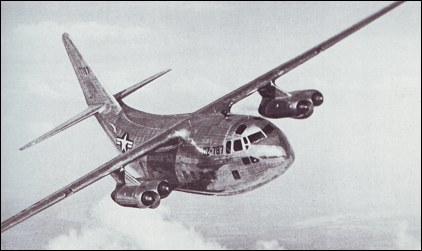 |
Chase XCG-20A1951 |  |
| EXPERIMENTAL JET CARGO TRANSPORT | Virtual Aircraft Museum / USA / Chase |
 |
Chase Aircraft Company was formed in New York in 1943 to design and build military assault gliders. On January 4, 1945 it flew the first XCG-14, a wooden 16-passenger glider, followed in October of that year by the 24-seat XCG-14A. In 1946 Chase switched to all-metal stressed-skin construction and a year later flew the 32-seat CG-18A. From this was derived the powered C-122 Avitruc for the US Air Force, with two 1425hp Wright R-1820-101 Cyclone engines. Much later (1959) the Hiller X-18 experimental VTOL mated a C-122 with a new 90° tilting wing with Allison XT40 turboprops and a Westinghouse J34 jet in the tail for control. Biggest of the Chase gliders, two airframes were built designated XCG-20, but neither flew as a glider. The first was finally completed with two R-2800-CB14 Double Wasp piston engines and became the prototype of the excellent C-123 Provider transport, which during the Korean war was ordered in quantity from Kaiser-Frazer who failed to deliver; finally 300 were built by Fairchild and the majority are still flying after a most successful career with the USAF and other operators. The second XCG-20 was structurally modified for engine nacelles at about the time (October 1949) that the XC-123 first flew, but no piston engines were ever fitted. Instead, under USAF sponsorship and with the enthusiastic backing of Chase's president and chief engineer Michael Stroukoff, it was completed with two twin jet pods each housing two General Electric J47 turbojets. The pods were based on those used on the B-36D and B-47B and C bombers, with a prominent splitter fairing upstream of the two inlets and with pointed fairings on the front of each engine front hub projecting in the centre of each inlet. Unlike the B-36 pod, there were no air shutters in the inlets. The pod was carried well below the wing, and was not swept forward as in the jet bombers but mounted on a conventional vertical pylon. The all-jet XCG-20A flew on April 21, 1951. Flight trials were excellent, and this somewhat oddball aircraft has a place in history as the first jet transport to fly in the United States and the first to fly with pod-mounted engines. Later, Chase's successor, Stroukoff Aircraft, rebuilt it as the XC-123D with boundary-layer control, and rebuilt it again as the 'pantobase' YC-134A. Bill Gunston "The Illustrated Encyclopedia of Commercial Aircraft", 1980
|  All the World's Rotorcraft | ||||||||||||||||||||||||||||||||||||||||||||||||||||||
 |

|
